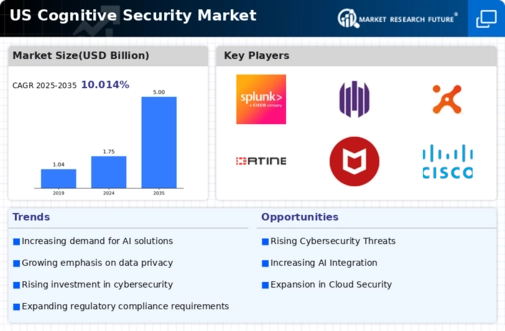The cognitive security market is currently characterized by a dynamic competitive landscape, driven by the increasing demand for advanced threat detection and response capabilities. Key players such as IBM (US), Microsoft (US), and CrowdStrike (US) are at the forefront, leveraging their technological prowess to enhance their offerings. IBM (US) focuses on integrating AI and machine learning into its security solutions, aiming to provide predictive insights that can preemptively address potential threats. Meanwhile, Microsoft (US) emphasizes its cloud-based security services, which are designed to protect users across various platforms, thereby enhancing its market position. CrowdStrike (US) has carved a niche with its cloud-native endpoint protection, which is increasingly vital as remote work becomes more prevalent. Collectively, these strategies not only bolster their competitive edge but also shape the overall market dynamics by pushing for innovation and comprehensive security solutions.
In terms of business tactics, companies are increasingly localizing their operations to better serve regional markets, which appears to enhance responsiveness to local threats. The market structure is moderately fragmented, with a mix of established players and emerging startups. This fragmentation allows for diverse offerings, yet the influence of major players remains substantial, as they set benchmarks for technology and service standards.
In October 2025, IBM (US) announced a strategic partnership with a leading AI research institute to enhance its cognitive security capabilities. This collaboration is expected to accelerate the development of advanced algorithms that can analyze vast amounts of data in real-time, thereby improving threat detection accuracy. Such a move underscores IBM's commitment to innovation and positions it to better compete against rivals by offering cutting-edge solutions.
In September 2025, Microsoft (US) launched a new suite of security tools aimed at small to medium-sized enterprises (SMEs). This initiative not only broadens its customer base but also addresses the growing need for affordable security solutions among smaller organizations. By tailoring its offerings to this segment, Microsoft is likely to capture a significant share of the market, further solidifying its leadership position.
In August 2025, CrowdStrike (US) expanded its global footprint by entering the Asia-Pacific market, establishing a regional headquarters in Singapore. This strategic move is indicative of the company's ambition to tap into the rapidly growing demand for cybersecurity solutions in that region. By localizing its operations, CrowdStrike can better understand and address the unique security challenges faced by businesses in Asia, potentially leading to increased market share.
As of November 2025, the cognitive security market is witnessing trends such as the integration of AI and machine learning, which are becoming essential for effective threat management. Strategic alliances among key players are shaping the competitive landscape, fostering innovation and collaboration. Looking ahead, it is anticipated that competitive differentiation will increasingly hinge on technological advancements and supply chain reliability, rather than solely on price. This shift suggests a future where companies that prioritize innovation and adaptability will likely emerge as leaders in the cognitive security domain.

















Leave a Comment